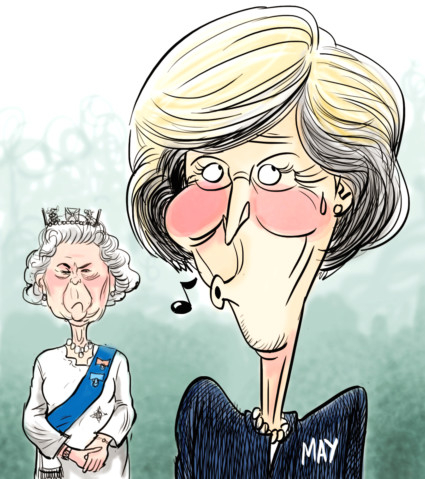In the introduction to his brilliant play The Audience, Peter Morgan writes that by dramatising the relationship between the Queen and her prime ministers “one was dealing with the British constitution, the bone structure of our establishment in its most elemental form”.
This is why it was so intriguing to read in last Friday’s Times of Her Majesty’s alleged frustration that British Prime Minister Theresa May declined to share her plans for Brexit during a stay at Balmoral in September. Naturally, No 10 and Buckingham Palace have refused to comment and one must always treat reports of the Queen’s private opinions with due caution. Only six months ago, both sides in the referendum were claiming her support, with evidence of varying quality. Yet, it would be odd indeed if the constitutional monarch had not asked May about her blueprint for Britain’s departure from the European Union (EU), which will, in principle, restore full sovereignty to the Queen in British Parliament, that composite entity in Britain’s system that merges what Walter Bagehot called its “dignified” and “efficient” elements.
The conversations that take place between HMQ and the prime minister — formal or otherwise — are the sanctum sanctorum of British government. Politicians who let slip what she has said (as former prime minister David Cameron did when he remarked that the Queen had “purred down the line” over the Scots’ vote against independence in 2014) can expect to be put on the royal naughty step. She herself reveals nothing of these discussions. Had the prime minister been so minded, she could have confided her plan in fine-print detail to the Queen without fear of the corgis talking out of school.
More to the point, to quote Bagehot again, the monarch has “the right to be consulted, the right to encourage, the right to warn”. So it was not unreasonable of the Queen to signal some interest in May’s proposals for the greatest institutional shake-up in the United Kingdom — well, since the 1972 Treaty of Accession.
‘Best possible deal for Britain’
Yet, this prime minister is the least garrulous and most cautious in living memory: She makes the sphinx-like former British prime minister Ted Heath look like English comedian Les Dawson gossiping over the garden fence. Journalists have been driven spare by her refusal to shift from the holding line that she will get the “best possible deal for Britain” — as if she might seek anything else. There will, she and her cabinet colleagues insist, be “no running commentary”.
Last week, she gave away nothing to the Commons liaison committee, other than the promise of a speech in the New Year. As one of her closest allies tells me: “They can all ask the question as many ways as they like, as often as they like. She’ll give them the same answer. It doesn’t bother her in the slightest.” Whether this strategy will prove resilient is another matter. The prime minister has already conceded that MPs will have a say on the triggering of Article 50. Parliamentary pressure will only grow for her to release further details of a plan that will, after all, decide Britain’s future role in the world.
All the same, it is hard not to admire May for her consistency. She stays mum with political journalists. She won’t let on when pressed by members of parliament. And — it now appears — she even stays silent when staying with the Queen.
It must have crossed her mind that this particular monarch’s first prime minister was Winston Churchill. That alone would be intimidating to most politicians and encourage them to share their greatest political secrets with the sovereign who has seen and heard it all.
But not, it seems, May. Her reticence may be infuriating, but it is absolutely democratic. Brexit means Brexit, she declares. But what does that mean?
We must keep guessing, it seems. Not even the Queen knows.
— Guardian News & Media Ltd, 2016
Matthew d’Ancona was previously editor of the Spectator and also writes for the Evening Standard and GQ.













